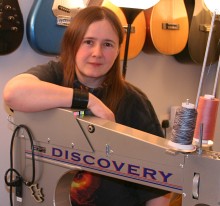The drive into Bath is worth doing in it's own right. Winding roads and undulating countryside are my sort of landscape. It was helped that the weather now seems to be moving into spring so everywhere was beautifully lit. The buildinmgs in Bath are also right up my street, solid older buildings made of stone. Perfect. I even got lucky with the parking, just outside the building. The Museum of Fashion is housed in the assembly rooms in Bath. It's a proper venue for a museum, an old building with impressive architecture and when there aren't functions on you can explore the building too.
The fashion exhibits were smaller than I had expected but wonderful none the less. You start at the exibit of clothes of the year. I have to say most of them did nothing for me. The exception being an outfit designed by Jeam Muir. It was one of the oldest in the section, which probably helped. The shape and tailoring were just lovely.
Moving on you get into an exhibit of underwear. They have some fantastic corsets on display, but sadly no postcards of them. From here you head into a history of dresses. From sack back dresses, through very wide skirts, via pelisse and into my favourite Victorian outfits. There were several garment on display here that I really love. One of Queen Victoria's dresses is on display. I was aware that she was short and stout, but it is quite different to actually see her dress. What really struck me though were the pockets. The dress had huge (yes even by my standards) and very prominent patch pockets. I could comfortably fitted everything in my pockets into them, and added everything I would have liked to have had with me. What was stranger, they looked stretched as though they had been used to carry large amounts. I can't see a current monach carrying that much let alone in patch pockets on her skirt. I'd love to know what she did use them for.
I also found several dresses that are in a similar style to one I have planned for the fashion show. I have meen very careful so say mine is 'victorian stlye' or inspired by victorian ouitfits, but actually it is going to be a lot more authentic than I thought. I had no idea they had decorated their skirt quite like that. I also realised that I am far too conservative to be victorian. Their fabrics and decoration were far more elaborate than most things I do. I was admiring the museums decision to show these gowns in quite low light levels. As well as protecting the cloth I would have thought the very orange lighting would have given a reasonable idea of what these dressed would have looked like in a room with fire based lighting. I was very disapointed when I found the sign apologising for the poor lighting, a fault they were trying to correct!
All in a a small but perfectly formed museum. Well worth a visit if you are in the area. For more information go to, www.museumofcostume.co.uk





2 comments:
All the furbellows on the clothes are part in due to the fact that now they had - TaDa! - Sewing Machines! It meant they hadn't got to sew everything by hand, so off they went (or their maid) and sewed on everything they could think of. And I suppose, with all the functions to attend, the competition increased the craze until it became fashion.
Fun really!
Makes you wonder how people will look at the advent of the embroidery module on sewing machines.
Sandy in Bracknell, who loves historical fashion.
I'll have to add this museum to my list - being a closet Victorian that is. Recreating Victorian clothing took up a lot of my sewing time before I got involved so much with quilting.
Post a Comment